| 1 | The most obscure US rattler |
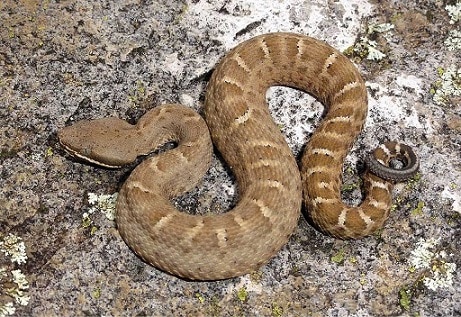
If the western diamondback is the rattlesnake species ordinary Americans are most likely to encounter, among the 15-20 in the US, the least likely is undoubtedly the ridge-nosed rattlesnake (Crotalus willardi). This is a small species which reaches an alltime record of just 67cm, and is typically 40-55cm. Crotalus willardi lives in only two states, and even then, tiny portions of them. 95% of their territory lies in Mexico, but they’re also found in extreme southeast Arizona and extreme southwest New Mexico.
Ridge-nosed rattlesnakes are never found in low-lying deserts. They’re a “sky island” rattlesnake which appears only above 1300 metres, inhabiting isolated mountain ranges well away from humanity. Encounters are few and far between, and even photographs are relatively few. Consequently, the ridge-nosed rattlesnake is the most recent rattlesnake to be discovered in the USA, first described in 1905.
This is a reddish-brown species, with a classic ID sign of a visibly raised snout, and a series of pale facial stripes. All ridge-nosed rattlesnakes have these stripes, though the width varies between the subspecies. For example, Crotalus willardi obscurus has the lightest facial stripes of the 5 subspecies. This is one of the 2 US subspecies, alongside Crotalus willardi willardi.
| 2 | Lives exclusively in mountainous regions |
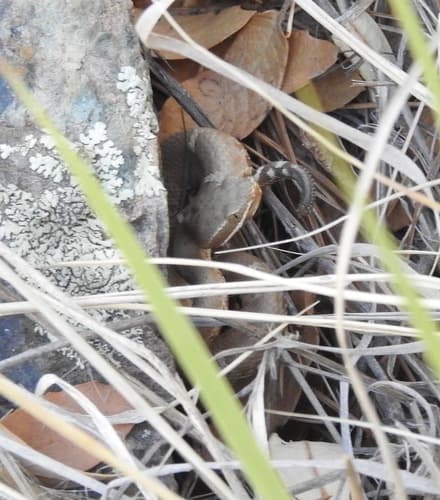
Ridge-nosed rattlesnakes are sometimes found in open meadows and mesquite grasslands at high altitudes. But they’re most common in mountainous forests, including pine-oak, scrub-oak and pine-fir. They’re especially abundant in woods near streams at the bottoms of canyons, and you’ll typically find them in areas coated with fallen pine needles and leaf litter. Rotting logs, and hollow stumps are a sign that ridge-nosed rattlesnakes may be nearby, and they typically range from 1475-2800 metres above sea level.
These environments give them many places to hibernate in. Typical winter lairs include rotting stumps, rock crevices, talus slopes (where they’ve been found up to 46cm deep) and logs. Ridge-nosed rattlesnakes are relatively flexible, having been observed active in air temperatures ranging from 6.8-30C. Their favourite activity range is 24-29C.
Crotalus willardi is a day-faring species, hunting under the glorious visibility of full daylight. The one exception is high summer, when they’re spotted hunting under darkness occasionally. They leave hibernation relatively late, as in Arizona, they’re active from April to mid-November, sometimes not leaving until early May.
| 3 | No confirmed fatalities (yet) |
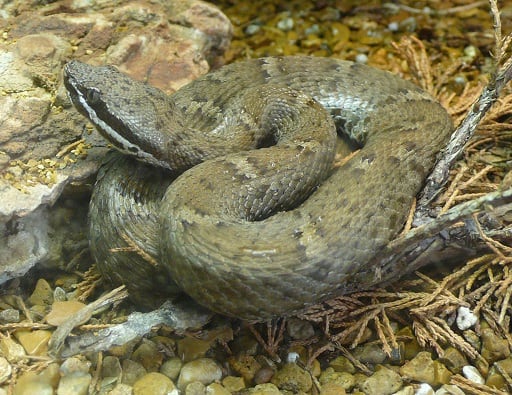
Encounters with Crotalus willardi are rare, bites are rarer, and confirmed deaths are non-existent. They don’t appear in backyards, alleyways, drainage ditches, car parks, or grassy parks in cities. It’s mainly hikers and determined scientists that encounter them. If you wanted to get bitten, you’d have to lie flat on your back in a Peloncillo Mountains pine-oak forest, and then it still might take weeks.
The most detailed bite report involved a healthy 57 year old male, bitten on his non-dominant hand. The main effect was strong edema (swelling) that progressed from his hand to mid-bicep. This limb also grew red and tender, with noticeable palpitations. Pain was minimal, but his hand lost much of its manoeuvrability.
The man experiened very few systemic effects, no nausea, vomiting or stomach pain. There was no spontaneous bleeding or delayed blood clotting. There was a slightly elevated D-dimer count (a biomarker for blood clotting) and a slight leukocytosis, elevated white blood cells. The man received the standard US CroFab antivenom, and recovered fully within 3 days.
| 4 | Diet: relatively flexible |
Ridge-nosed rattlesnakes eat a mixture of lizards, mammals and birds, but the exact proportions vary depending on which forested mountain ranges they live in. For example, a 2005 study from the Sierra Madre Occidental of northern Mexico followed 197 ridge-nosed rattlesnakes, discovering 103 prey from 92 individual rattlesnakes. It found an overall dietary breakdown of 54.4% reptiles, 10.7% mammals and 21.4% birds. There was also a dosage of venomous centipedes (13.6%).
There was a shift away from reptiles and towards mammals with age, and the single favourite prey item was the striped plateau lizard (Sceloporus virgatus), which was found 14 times. The second placed species was from the same family: Clark’s spiny lizard (Sceloporus clarkii), recorded 6 times.
Scientists have noticed varying hunting tactics based on prey type. With mammals, ridge-nosed rattlesnakes lunge, envenomate, then immediately relinquish their prey, and track them through the undergrowth until they weaken and succumb. In western diamondback rattlesnakes, these tracking molecules have been pinpointed as disintegrins. With lizards, ridge-nosed rattlers keep them in their clutches while they weaken. With birds, they not only maintain their fang-hold, but wrap around a securing bodily coil, to prevent a flapping escape.
| 5 | Lurks by fallen tree trunks |

Meanwhile, an earlier 2002 study examined three locations: the Animas Mountains (New Mexico), Peloncillo Mountains (Arizona/New Mexico) and Sierra San Luis (Mexico). This time, mammals featured more heavily, at 62.3% of prey in adults, versus 26.4% for lizards and 9.4% for birds. Juveniles were biased towards lizards, at 57.1%. The overall meals didn’t vary, just the proportions. In both studies, not one amphibian was observed as prey. This study involved 95 identifiable prey from 246 individual ridge-nosed rattlesnakes.
This time, the top reptile prey was the Yarrow’s spiny lizard, AKA Sceloporus jarrovii. Again, the study noticed varying hunting techniques. With small mammals, the favourite being the brush deermouse (Peromyscus boylii), ridge-nosed rattlers positioned themselves at the bases of trees, directly next to fallen branches and logs, which the mouse then used as a runway, before snatching them off the surface.
With reptiles, they positioned themselves next to rocks and vertical fissures instead, with their hidden head aiming for the surface of the rocks. As for birds, ridge-nosed rattlesnakes have been observed snatching them from the shores of pools within forests. Crotalus willardi rarely climbs trees, reaching a maximum of 42-61cm above ground, but may pinch birds from branches very occasionally.
| 6 | Life of a ridge-nosed rattler |
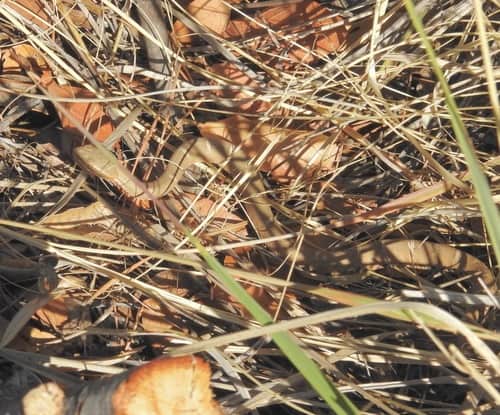
One of the ridge-nosed rattlesnake’s largest confirmed prey is Tamias dorsalis, AKA the cliff chipmunk. This rattlesnake isn’t an infamous snake eater, but a 1947 report listed the night snake (Hypsiglena torquata) as prey. The western lyre snake (Trimorphodon biscutatus) is also confirmed. As for deadly centipedes, their hunting strategy has been observed in captivity. Ridge-nosed rattlesnakes raise the front half of their body, strike downwards at the centipede, then rapidly withdraw to avoid their deadly stingers.
Like most rattlesnakes, Crotalus willardi can easily exceed 20 years, when they’re not fending off swooping hawks and coyotes. A female ridge-nosed rattler caught as a juvenile lived an additional 21 years, 3 months and 24 days in a collector’s enclosure in Dallas, Texas.
Ridge-nosed rattlesnakes are also a wrestling species. This was observed for the first time in August 2008, in Arizona’s Patagonia mountains. A dark and light male were seen duelling in a rocky forest with low-lying branches, coiled around each other, occasionally constricting, attempting to raise each other’s head above the opponent, to prove their superiority. They were observed wrestling for 16 minutes, but the battle may have been more gruelling than that. In the midst of their duel, they used the low dangling branches for support. No female was spotted nearby, but they may have been competing for her affections.
| 7 | Newborns obey their mothers |
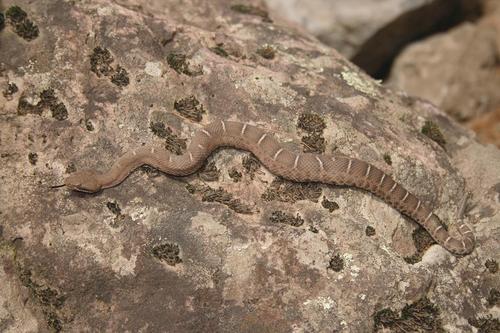
According to a 2003 study, female Crotalus willardi are capable of reproducing once they reach 38cm. Pregnant females have been encountered at 45.2-48.1cm long. Litters vary from 2-9, with a average of 5.2 across 30 clutches. Among 81 neonates the average newborn size was 18.1cm, ranging from 15.0-22.2cm. This is significantly shorter than the black-tailed rattlesnake at 22.9 to 31.8cm.
Mothers are confirmed to stay with their newborns for several days, lurking under the cool shelter of rocks. In August 2008, scientists climbed into the heart of Crotalus willardi country, in the Patagonia mountains of southern Arizona. There they spotted a female ridge-nose with 6 neonates nearby, resting on a damp hillside. The neonates had blue eyes, proving that they hadn’t shed their first skin yet. When the mother turned to slither into some rocks, the neonates obediently followed her. 2 hours later, the scientists found the mother resting beneath a large rock, with all 6 neonates resting on top of her.
Two more Crotalus willardi females were resting on the same hillside. Both were pregnant, but a male ridge-nosed rattlesnake soon arrived, and began classic courtship acts like tongue flecking and jerking its head. This was possibly the father of the expected offspring. In timber and pygmy rattlesnakes, males are confirmed to guard their pregnant females.
| 8 | Abundant in certain spots |
Crotalus willardi is the most restricted of all rattlesnakes in the USA. West diamondbacks roam a vast unbroken area from California to Arkansas, but Crotalus willardi is limited to obscure sky islands, towering above everyone else, which few humans ever visit. Yet once you reach these narrow kingdoms, they can suddenly be plentiful. It’s estimated that ridge-nosed rattlesnakes are the single most common snake in certain mountainous locations.
There may be zero ridge-nosed rattlesnakes one minute, but climb a steep hiking trail for an hour, and a thriving colony may appear all at once as you ascend the final ridge. In 1983, a Mr Johnson found 6 in just 2 hours in a canyon. In the 1970s, Armstrong and Murphy discovered 11 over two hours in northern Sonora. They captured 11 from July 15th to July 23rd 1973, and in Durango, they collected 5 in one day post heavy rains.
Many reports suggest that Crotalus willardi appears after heavy rains, emerging from their underground hidey holes. They’re also skilfull at dodging wildfires. When 3 radiotracked ridge-nosed rattlesnakes were studied in the Peloncillo mountains in 2001, all 3 survived the approaching flames by disappearing into underground burrows. One was a pregnant (gravid) female.
| 9 | Mysterious venom variability |
Ridge-nosed rattlesnakes are relatively mild, but watch out, as the venom varies significantly between the subspecies. In a 2017 study, 4 Crotalus willardi subspecies were tested for various parameters. All 4 venoms were abundant in type I and type III metalloproteinases, but Crotalus willardi silus (found in northern Mexico) stood out for massively delaying blood clotting, with a clotting time of 83 seconds. The other three were far milder, at 18-22 seconds, with the US Crotalus w. obscurus being the weakest at 18s.
The venoms were also tested on fibrinogen, which converts directly to fibrin, the physical backbone of blood clots. Crotalus willardi willardi strongly degraded both alpha and beta subunits, but another two were much weaker against the beta subunits. Matching the clotting scores, the weakest subspecies was Crotalus w. obscurus, which only slowly degraded both the alpha and beta fibrinogen subunits.
Overall, Crotalus willardi was far weaker against fibrinogen than the 4 rock rattlesnake (Crotalus lepidus) subspecies tested, which is backed up by reality, as rock rattlesnakes have far stronger haemorrhaging powers in human case studies. We’re nowhere close to unravelling all the mysteries, but like a southwestern speckled rattlesnake, Crotalus willardi may be deadlier in isolated mountain locations.
| 10 | Variable venom with age |
The study also tested the 4 subspecies against various animals, and discovered yet more variation. Crotalus w. silus was the strongest against centipedes, with an LD50 score of 1.94mg. Crotalus w. willardi specialised in lizards, scoring 1.43mg. The strongest against mammals was Crotalus willardi obscurus, achieving 1.58mg, and this coincided neatly with the 2002 diet study, which tested this subspecies and found a much richer diet in mammals than the 2009 diet study, which tested C. w. willardi. The ridge-nosed rattlesnake may adapt its venom to varying ecosystems in different mountain ranges.
The 2002 study also found variation with age. Adult venom had an LD50 toxicity score of 6.4mg against lab mice, but as a juvenile, they scored a stronger 4.3mg. This may be to compensate for the lower venom yields of young rattlesnakes. Ridge-nosed rattlesnakes already have a pitiful venom yield as an adult, injecting just 3.1mg per bite.
Another random fact is that ridge-nosed rattlesnakes have a colourless venom, similar to tiger rattlesnakes, and differing to the yellow venom of a black-tailed rattlesnake. Among 5 ridge-nosed rattlesnakes measuring 51.7-57.9cm, the average fang length was 5.7mm, ranging from 5.3-6.0mm.
